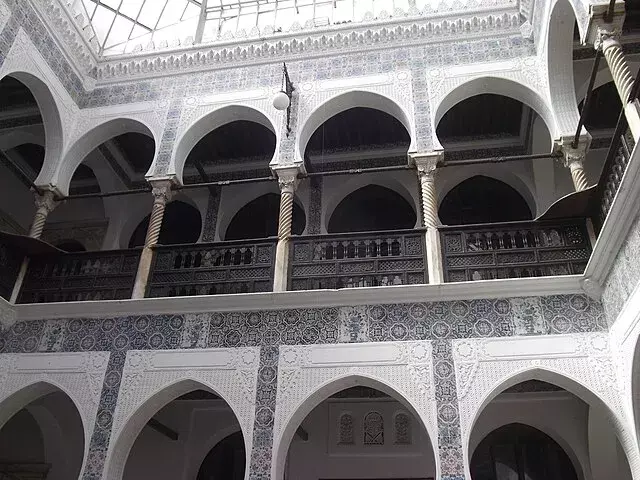
Dar Hassan Pacha
Overall Rating: ⭐⭐⭐⭐☆ (4/5)
Rating Breakdown:
✔ Historical Significance – ⭐⭐⭐⭐⭐ (5/5)
✔ Architectural Beauty – ⭐⭐⭐⭐⭐ (5/5)
✔ Accessibility – ⭐⭐⭐☆☆ (3/5)
✔ Tourist-Friendly – ⭐⭐⭐☆☆ (3/5)
✔ Maintenance & Preservation – ⭐⭐⭐⭐☆ (4/5)
Weather
- Algiers experiences a Mediterranean climate characterized by hot, dry summers and mild, wet winters.
Tags
- Historic Palace, Ottoman Architecture, Cultural HeritageDiscover the World with Evendo+1Wikipedia+1
Timings
- Visiting hours may vary; it's advisable to check locally or with tour operators for current schedules.
Time Required
- A visit typically requires 1 to 2 hours to explore the palace thoroughly.
Entry Fee
- Entry fees, if applicable, should be confirmed on-site or through official channels.
Things to See & Do
- Architectural Exploration: Admire the blend of Moorish and neo-Gothic architectural styles, including the intricately designed façade and interior courtyards.
- Historical Significance: Learn about the palace's role as the residence of Hassan III Pasha and its subsequent use as the French Governor's winter residence post-1830. Interior Décor: Observe the detailed plasterwork, tile mosaics, and the central courtyard adorned with lush greenery.
Best Time to Visit
- Spring (March to May) and autumn (September to November) offer pleasant weather, ideal for exploring the palace and the surrounding Casbah.
Nearest Parking Spots
- Parking in the Casbah is limited; utilizing public transportation or taxis is recommended.
Overview
- Dar Hassan Pacha stands as a testament to Algiers' rich history and architectural splendor. Constructed in 1791 by Hassan III Pasha, the palace has witnessed significant historical events and transformations. Its strategic location in the Casbah, a UNESCO World Heritage site, adds to its cultural importance.
- Main Façade: A remarkable example of Moorish architecture, later enhanced with neo-Gothic elements during the 1839 remodeling.
- Central Courtyard: Features traditional Islamic design with a serene garden and intricate tile work.
- Reception Halls: Once used for official audiences and hosting dignitaries, including Emperor Napoleon III and Empress Eugénie during their 1860 visit.
- Commissioned in 1791 by Hassan III Pasha, the palace served as his residence and a venue for official functions. Following the French conquest in 1830, it became the winter residence of the French Governor, undergoing significant remodeling in 1839, including the addition of a new façade. Notably, Emperor Napoleon III and Empress Eugénie stayed here during their 1860 tour of Algiers.
- The palace showcases a harmonious blend of Moorish and neo-Gothic architectural styles.
- The original design features traditional Islamic elements such as a central courtyard, ornate plasterwork, and tile mosaics.
- The 1839 renovations introduced neo-Gothic influences, particularly evident in the façade's design.
- Guided Tours: Engaging a local guide can enhance the experience by providing in-depth historical context.
- Dress Modestly: As a site of cultural significance, it's respectful to wear modest attire.
- Photography: Check for any restrictions on photography within the palace premises.
- Safety: Stay aware of your surroundings, especially when navigating the narrow streets of the Casbah.
- By Foot:
- Located in the lower Casbah near the Ketchaoua Mosque, it's accessible through the winding streets of the old city.
- By Public Transport: Buses and taxis can drop visitors near the Casbah; from there, it's a short walk to the palace.
- By Car: Due to limited parking, it's advisable to use public transport or park in designated areas outside the Casbah and proceed on foot.